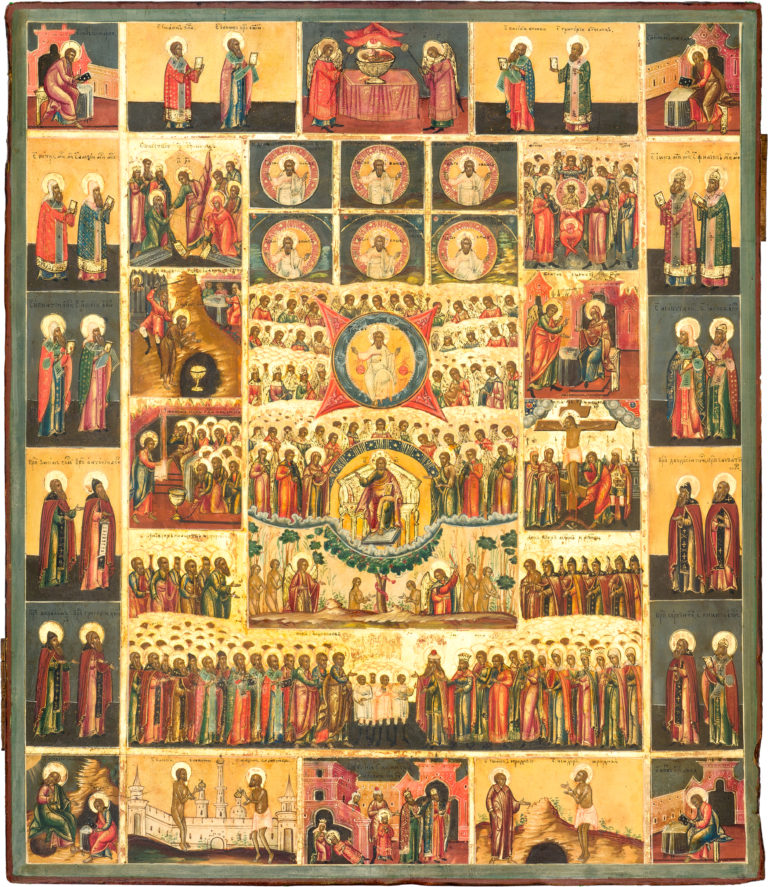The Hexahemeron
Antique Russian icon. Around the middle of the 19th century. Palekh (?)
Size: 36 х 30 x 2.5 cm
Wood (two panels), two incut profiled support boards, absence of an incut centerpiece, underlying layer of canvas not visible, gesso, tempera.
The author’s paintwork is in good condition. Slight chafing of the paint layer on the religious icon borders.
Contact us

The Hexahemeron
The Eastern Orthodox iconography of the Hexahemeron was formed under the influence of the Church Fathers (Basil of Caesarea, George of Pisidia, John – the Exarch of Bulgaria, etc.), who left treatises on the Biblical creation narrative, according to which God made the world in six days. The complex composition of the Hexahemeron Orthodox icons traditionally includes the Etimasion (the Return of Christ on Judgement Day), the Deesis with Christ in Majesty or Christ Emmanuel, the Feasts of the six week days, and the Sabbath of All Saints. Such hand-painted icons made their appearance in the end of the 15th century, probably because of the eschatological awaiting of the end of the world. The fact is that the year 1492 marked the end of the 7,000 year period, which symbolically coincided with the six days of creation, after which God “rested from all His work,” while the eight day was seen as the day of the Second and Great Coming of Christ. In the following period, the Hexahemeron iconography became even more complicated, and in the late 18th-early 19th centuries, it was drastically re-worked by the Palekh religious icon painter V.I. Kokhlov, who added the scenes of Creation and the figures of the saints on the borders, turning it into a clear iconographic scheme. This clear composition, instantly recognizable due to its structure and color scheme, allows us to consider such hand-painted Orthodox icons, widespread in the 19th century, to be the work of Palekh’s iconographers, most notably of Kokhlov’s workshop.
The centerpiece of the given antique Russian icon consists of several different scenes. The main axis is occupied by six Creation scenes (Genesis 1:3-31), God Sabaoth surrounded by the Angelic host, Christ the Judge seated on a throne with the Mother of God, John the Baptist, and the Heavenly Powers in prayer before Him, the Tree of Life with scenes of the Fall of Man and Exile of Adam and Eve from Paradise. Then follow the six Feasts that, according to the teachings of Saint Constantine-Cyril the Philosopher (9th century), were symbols of the six week days, with Saturday (or Sabbath) lacking one. Sunday symbolized the Harrowing of Hades; Monday – the Feast of the Archangels; Tuesday – the Beheading of John the Baptist; Wednesday – the Annunciation; Thursday – the Washing of the Feet; Friday – the Crucifixion. The seventh day – the Sabbath of All Saints – is represented in the lowest tier of the centerpiece.
The religious icon centerpiece is surrounded by border scenes, depicting the Evangelists, Church Fathers, Metropolitans, Monastic saints, the Blessed, and the Fools-for-Christ. The introduction of such a troop of saints can be explained by the Russian desire to depict in hand-painted icons the most venerated saints following the strict hierarchical principle. The topmost tier is meant for the Ecumenical Church Fathers and Saints: Basil the Great, John Chrysostom, Gregory the Theologian, and the Apostle James – the Brother of the Lord. The border scenes of the religious icon are also occupied by pairs of Holy Bishops: Peter and Alexius, Jonah and Philip, the Metropolitans of Moscow and the Rostov Archbishops – Ignatius and Isaiah, Leontius and Jacob. Then come the monastic saints – Zosima and Sabbatius of Solovetsk, Anthony and Theodosius of Pechersk, Varlaam of Khutynsk and Gregory Decapolites, Sergeius of Radonezh and Niketas, the Archbishop of Novgorod. In the lower tier, the scene of the murder of Saint Tsarevich Demetrius is flanked by the figures of the Blessed and the Fools-for-Christ: Basil and Maxim of Moscow (on the left), John the Big Hood and Isidore of Rostov (on the right).
The stylistic traits of the given hand-painted icon, including the desire to escape overt decorativeness, the draft-like treatment of the vestments, mountains and architecture, the silhouettes of the figures, the rather harsh gold-hatching, and the active color juxtaposition of the greyish blues and bright yellows in the background, allow one to consider this antique Russian icon to be a piece of work of mid-19th century iconographer closely tied to the Palekh tradition of religious icon painting.